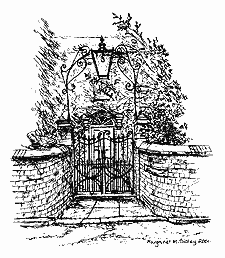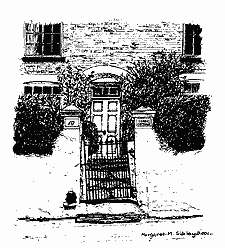![]()
The Banks and Fisher Lane
Until the late 19C The Banks had only a few late 18C and early 19C farm and cottager plots and not much else. No20 Tithby Road and Nº9 opposite were a small farm complex on the Chesterfield estate. No 9 is on the site of one of three windmills shown on the 1835 Sanderson Map. The garages of No20 were cowsheds and straightening of Tithby road in the 1960s took some land from in front of these. On the north side of The Banks at the Tithby Road end the Victorian development was on the old Walker farmland and built by James Walker, as one would expect. The pair of late Victorian detached houses (Nºs7 & 9) are particularly impressive. Built as Manses for Methodist ministers to replace the older ones at the bottom of Kirkhill, they were used as such for over 100 years until the 1980s. The rest of the Walker farm land was developed in the 1960s to form Melvyn Drive (named for the son of the developer Frank Sturtivant) and Banks Crescent.
| The older properties on the south side were initially cottages on the 'waste' with small plots of land as closes or orchards. Mid 19C infill and replacement of older cottages followed and a number of the houses have date stones. No6 is another of James Walker's detached villas, being similar to Westholme as is probably number 5 although it has square rather than trapezoid bay windows. Walker built numbers 24-26 (Banks Cottages) and 28-30 (Grove Cottages) in 1896. Ebenezer House (1911) looks like another Walker detached villa but it is not quite. Albert Squires (father of the present owner) built it for his family with the help of one labourer. He named the house after the Stone of Help because he thought the Lord would help him build it. He was a jobbing builder employed by Walker, so the design may well have come from the pattern book used for the other villas, albeit somewhat reduced in size. On the north side east corner with Fisher Lane are three interesting houses - a pair of semi-detached cottages from the mid 19C (Nºs15 and 17) and an Italianate Gothic Revival house (Nº19), about which nothing seems to be known, from perhaps the 1850s with fancy stone quoins and arched windows. The style bears some resemblance to the Wesleyan School and the Old Court House. Qualified observers think it was architect designed for either a professional person, academic or cleric. The 1990's houses on the south side (Nºs34-38) are infill built on the last of the famous Victoria plum orchards of Bingham. The style bears some resemblance to the Wesleyan School and the Old Court House. Banks House is an 18C farm still with barns (one is the boxing club). The garden gate ironwork with lantern recalls that at the east gate of the church and is likely to be from about 1850. |
 Banks House |
The original part of Banks Cottage (extended in the 1990s) is from the mid 19C. The wood enclosed pump, a ubiquitous feature of pre-1920 houses in Bingham, but often now gone or hidden from public view, can be clearly seen. Jebb's Lane is an ancient sunken track, named for 'Old Jebb' a squatter who erected a cottage on the NE corner (shown on maps from the 1830s and as late as 1901). Appletrees carries a plaque recording its date of building 1925 and rebuilding 1990. The architect John Beetham Shaw built it for his own use in the grounds of his former house on Long Acre. The modern Beetham Close, on some of the original Eskdale House land, is named in his memory. The remaining areas of the Banks contain much late 20C infill. The cemetery was opened by the RDC in 1881 when the churchyard became full. Opposite the cemetery you can see some of the few remaining trees of Bingham's famous old orchards.
![]()
Fisher Lane
Until 1974 Fisher Lane was developed only on the east side. West were orchards except for a builder's yard at the northwest end. The east side has many interesting properties both in terms of building style and position. The oldest face south, are end on to the street and arranged in a traditional strip pattern. The raised ground has led to some deep foundations. Bingham's only remaining fire insurance plate is attached to the front of Norton Cottage.
Priory Mews were previously four small cottages. They were given to the town in the 1940s to form the basis of the youth club, which was called Baxter House after the donor, Mrs Baxter. When the youth wing at Toothill School was opened the old club was sold to convert to the present flats and the cash used to form the Bingham Trust charity for young people. No11 used to be the Toc H meeting rooms.
| Long Acre House was built by the architect and builder John Doncaster about 1840 as Providence House. In the late 1800s it was The Chestnuts and later it became Orchard Close (the name is carved on a gate pillar capstone at the Doncaster Yard entrance to the house). The original entrance was from Long Acre before a cottage was demolished to provide access to Fisher Lane. It retains an attractive stable block, now used as offices. Lushai Cottage dating from the
mid 19C was the home in 1891 of James Prior Kirk, author
of Ripple And Flood in 1897 and the better-known Forest
Folk in 1901. Later he moved to Banks Cottage. Previously
called Brusty Cottage, it was owned in the 1940s by
Col. Johnson (brother of the watchmaker of Cherry Steet)
who had served in India. He may have named it after
the Lushai Hills District of North East India (now called
Mizoram).
|
Lushai Cottage |

